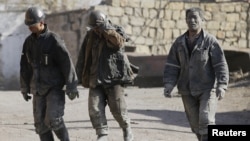Days of protests by coal miners in northeastern China’s Heilongjiang province has forced a top official to issue an apology over unpaid wages.
The dispute is one small example of the tough challenges China faces as it seeks to shed overcapacity and transition labor away from state-owned enterprises, analysts say.
The protests reached a boiling point over the weekend after thousands of unpaid workers in Shuangyashan packed the city’s streets and blocked the railway in protest of what they called a “fat lie” told by provincial Governor Lu Hao.
The miners are employed by the Shuangyashan Mining Industry Group, a subsidiary under Heilongjiang Longmay Mining Holding Group.
“What the Shuangyashan incident has exposed is just a tip of the iceberg. It has been pretty endemic (workers not getting paid). As the economy in China continues its slowdown, the [labor] dispute is getting worse,” said Liao Cheng, a rights activist from Heilongjiang.
Last Sunday, Heilongjiang Governor Lu told leaders at China’s so-called "two sessions" in Beijing that Longmay, the largest state-owned coal mining group in his province, has never been late in paying its 80,000 workers, stressing that “not a penny is overdue.”
Angry workers
But Lu’s comment immediately angered many coal miners in his hometown, who complained that they haven’t received paychecks for more than six months.
During the demonstrations, crowds chanted furiously, “Give our wages back. Give our wages back. We need to eat,” while their banners read, “We want to survive” or “The Communist Party owes us money.”
Videos and pictures of the massive demonstrations, posted on social media, showed protesters flooding the streets, gathering in front of the city’s coal mine bureau and at train stations. Authorities sent hundreds of riot police to forcibly break up the rally and make arrests.
In footage seen online, one man conveyed that he saw riot police with shields and batons passing by, numerous clashes, with the police beating people.
As clashes intensified during the weekend, Lu was forced to extend an apology late Sunday to ease public outrage. According to a Beijing Times report on Monday, the top official admitted, “A mistake is a mistake. There are no excuses.”
But on the website Freeweibo.com, Shuangyashan was the top trending censored topic. Many users argued the incident shows how corrupt the province’s officials are, with some urging Lu “to take the blame and step down.”
Official apology
Lu said that he was misinformed and had held a meeting on Saturday to discuss measures to turn debt-ridden Longmay around.
The governor concluded that, with support from his government, Longmay will soon raise funds to repay workers, while relocating as many as 50,000 elsewhere, such as in the local food, dairy and tourism sectors, which he said have a healthy outlook over the next two to three years.
But labor activists were not as optimistic the dispute would come to an end soon.
“It’s one thing for the governments, for the provinces to promise. It’s quite another for the companies involved to actually get those funds together to ensure that workers are actually paid. So, I have my doubts the issue will be resolved straight away,” said Jeff Crothall, spokesman of Hong Kong-based China Labor Bulletin.
The coal mining industry is seriously burdened with overcapacity. Last year, more than 90 percent of the nation’s coal mines suffered losses.
China National Coal Association’s latest statistics show that the sector produced 3.37 billion tons of coal in the first 11 months of last year, down 3.54 percent from the year previous.
Over the next three to five years, the government plans to further shed or restructure output by one billion tons, said Zhao Chenxin, spokesman of National Development of Reform Commission.
Overcapacity is a huge challenge also facing many of the nation’s other traditional heavy industries, which are mostly state-owned.
A smaller headache?
Although the reform of state-owned enterprises is no easy task, the management of its redundant employees today is a relatively smaller headache compared to the previous crisis the enterprises suffered in 1993-1994, said Cao Heping, professor of economics at Peking University.
“The difficulty today is a lot smaller. Back then, there were 30 million redundant employees. Today, the number is estimated to be under 1.8 million,” the professor said.
Out of the 1.8 million, the actual number of workers being laid off will be smaller after state-owned enterprises follow through their restructuring, merger and acquisition plans, which will help retain talent, he said, expressing confidence that the Chinese government is now in a better position to weather through a smaller crisis.











